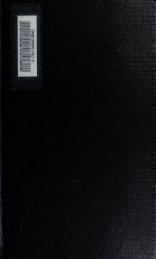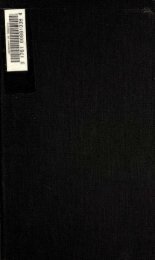Texts from the Buddhist canon : commonly known as Dhammapada
Texts from the Buddhist canon : commonly known as Dhammapada
Texts from the Buddhist canon : commonly known as Dhammapada
You also want an ePaper? Increase the reach of your titles
YUMPU automatically turns print PDFs into web optimized ePapers that Google loves.
30<br />
PREFACE.<br />
with this introductory phr<strong>as</strong>e, " Thus have I heard." The<br />
place where <strong>the</strong> sermon w<strong>as</strong> preached is also given, and<br />
<strong>the</strong> occ<strong>as</strong>ion and circumstances of it. It w<strong>as</strong> <strong>from</strong> <strong>the</strong>se<br />
works that <strong>the</strong> Shamans, in after years, copied out <strong>the</strong><br />
various G§,th<strong>as</strong>, some of four lines, some of six lines, and<br />
attached to each set a title according to <strong>the</strong> subject <strong>the</strong>reia<br />
explained. But aU <strong>the</strong>se verses, without exception, are<br />
taken <strong>from</strong> some one or o<strong>the</strong>r of <strong>the</strong> accepted Scriptures,<br />
and <strong>the</strong>refore <strong>the</strong>y are called Law-verses (or Scripture<br />
extracts), because <strong>the</strong>y are found in <strong>the</strong> Canon.<br />
Now <strong>the</strong> common edition used by people generally is<br />
<strong>the</strong> one with 7bo Gath<strong>as</strong>. The meaning of <strong>the</strong>se GS,th^s<br />
is sometimes very obscure (deep), and men say that <strong>the</strong>re<br />
is no meaning at all in <strong>the</strong>m. But let <strong>the</strong>m consider that<br />
<strong>as</strong> it is difficult to meet with a teacher like Buddha, so<br />
<strong>the</strong> words of Buddha are naturally hard of explanation.<br />
Moreover, all <strong>the</strong> literature of this religion is written in<br />
<strong>the</strong> language of India, which widely differs <strong>from</strong> that of<br />
China— ^<strong>the</strong> language and <strong>the</strong> books, in fact, are those of<br />
<strong>the</strong> Dev<strong>as</strong> (Heaven). So to translate <strong>the</strong>m faithfully is<br />
not an e<strong>as</strong>y t<strong>as</strong>k.<br />
The present work, <strong>the</strong> original of which consisted of 500<br />
verses, w<strong>as</strong> brought <strong>from</strong> India in <strong>the</strong> third year of <strong>the</strong><br />
reign of Hwang-wu (a.d. 223), by Wai-chi-lan, and, with<br />
<strong>the</strong> help of ano<strong>the</strong>r Indian called Tsiang-im, w<strong>as</strong> first ex-<br />
plained, and <strong>the</strong>n translated intO' Chinese. On some objec-<br />
tion being made <strong>as</strong> to <strong>the</strong> inelegance of <strong>the</strong> phr<strong>as</strong>es<br />
employed, Wai-chi-lan stated " that <strong>the</strong> words of Buddha<br />
are holy words, not merely elegant or t<strong>as</strong>teful, and that<br />
his Law is not designed to attract persons by its ple<strong>as</strong>ing<br />
character, but by its deep and spiritual meaning."<br />
Finally, <strong>the</strong> work of translation w<strong>as</strong> iinished, and after-<br />
wards 1 3 additional sections added, making up <strong>the</strong> whole<br />
to 752 verses, 14,580 words, and headings of chapters,<br />
39-





